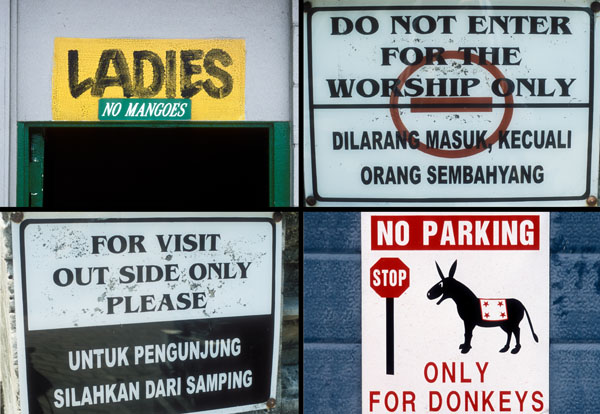Signs are part of our everyday lives and in that sense quite unremarkable. They advise us of the hazards of the road and direct us to places to which we want to travel. In cities huge illuminated signs advertise hotels, restaurants and products of every conceivable type. In Hong Kong there are so many overhead advertising signs that is can be difficult to see the sky.

Most signs are not sufficiently interesting to attract a photographer’s eye, but when we travel worldwide we see them in a somewhat different light. Not only do the signs display unfamiliar colours and designs, but unintended humour and indecipherable languages and characters that make graphic images. We therefore wonder at their purpose as we pass them, perhaps smiling at those clearly intended for illiterate foreigners.
Signs that announce our arrival at significant points in a journey, or at well known locations, have additional photographic interest. They are a measure of progress and can be used to link places in the pages of photograph albums. To some they are an end in themselves; trophies that say “We made it this far!” What modern polar traveller has returned from the South Pole without a shot of the striped pole marking the earth’s axis of rotation?
Other signs that are worth photographing are those that are humorous or attractive in their own right. Signs that are humorous, intentionally or otherwise, may be found almost anywhere. Some use humour to achieve a particular objective, and others exist purely to make us smile. Whatever the case, the varied nature of national senses of humour can make these interesting subjects. Finally, lots of modern signs are beautifully designed using bold graphics and colours, perhaps combined with spectacular neon lighting, to catch our eye and influence our purchasing decisions. Those that are illuminated make spectacular images, when photographed at night, particularly when they can be isolated from background clutter.
Photographing signs in daylight is relatively straightforward. Choose an angle that isolates the sign form its surroundings, or use a wide-angle lens with a small aperture close to the sign. The latter approach makes possible the inclusion of the environment in which the sign stands and therefore provides context. At night it is worth a few minutes to observe any changing sequence of illumination before deciding how to photograph a particular sign. Use a tripod and select a shutter speed long enough to incorporate the illumination required, or just capture the best stage in the sequence of changes. If the sign more or less fills the frame, a normal automatic exposure may work well, but if much of the background is dark it may be necessary to reduce the exposure by one or two stops to avoid overexposure.






